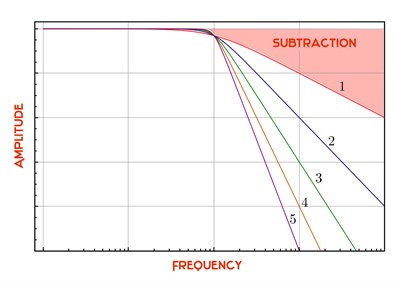Subtractive Synthesis
Examining subtractive synthesis
 Subtractive synthesis is a type of sound synthesis used to create new sounds by filtering out or subtracting specific frequency components from a rich, harmonically complex signal.
Subtractive synthesis is a type of sound synthesis used to create new sounds by filtering out or subtracting specific frequency components from a rich, harmonically complex signal.
1. Sound Source / Oscillators
This method of synthesis works by starting with a sound source, usually an oscillator, that produces a waveform with many harmonics. Common analog oscillator shapes are Sine, Triangle, Square and Sawtooth.
Sine - a sine wave focuses all the sound energy on a single fundamental frequency, so its not a great oscillator source to use for subtractive synthesis, since it doesn't have a bunch of overtones / harmonics above the fundamental.
Triangle - a triangle shaped oscillator produce harmonics above the fundamental frequency, at odd harmonic series points.
Square - a square shaped oscillators (also known as a pulse wave with 50% duty cycle) also produces harmonics at odd harmonic series points, though the amplitude of the harmonics is significantly higher than the Triangle shape.
Sawtooth - a sawtooth shaped oscillator provides the most harmonically rich series of harmonics/overtones, hitting both even and odd harmonic points in the harmonic series. The sawtooth has the most full sound, which is conducive to subtractive synthesis.
2. Subtractive Filtering of the Source Sound and Harmonics
The signal is then routed through a series of filters and amplifiers, which selectively remove certain frequencies and shape the overall timbre of the sound. The filters used in subtractive synthesis are typically low-pass filters, which allow lower frequencies to pass through while attenuating higher frequencies. By cutting off the high end or low end of the sound source, this produces a filtered sound, removing some of the upper harmonics, or cutting out the fundamental and lower harmonics, with a high-pass filter. The filter strength is generall rating as 1-Pole, 2-Pole, 3-Pole, or 4-Pole. Each pole represents a 6 decibal per octave drop off above the filter cutoff point. So if you are using a more dramatic 4-Pole filter, set at a cutoff point of C5 (523 hertz), there will be a falloff (or subtraction) off all the sound above that C5 cutoff point -- and with 4 poles, that will be a total of 24 decibals in sound reduction for each octave above C5. So, at C6, the amplitude of the harmonics will be 24db quieter.
3. Envelopes Control the Filter and Amp Volume
Generally, synths have a couple time envelopes that can be used to control filter movements and overall amp/volume curves of the sound. Envelopes are really at the heart of subtractive sound design, as you can take a given sound source, and completely alter the timbre and sound profile of it by adjusting how the filter moves and amp volume moves over time after you strike a key. You can make the same sound source into a Lead, a Bass, Strings, Brass, or a Pad, just by altering how the envelope attack, decay, and release control the movement and amplitude of the filter cutoff and volume.
Subtractive synthesis is a very common technique in analog synthesizers, from the earliest monophonic and poly synths in the 1950s through 1980s, up until modern day. Subtractive synthesis (both analog and digital) remains one of the most popular types of synthesis.